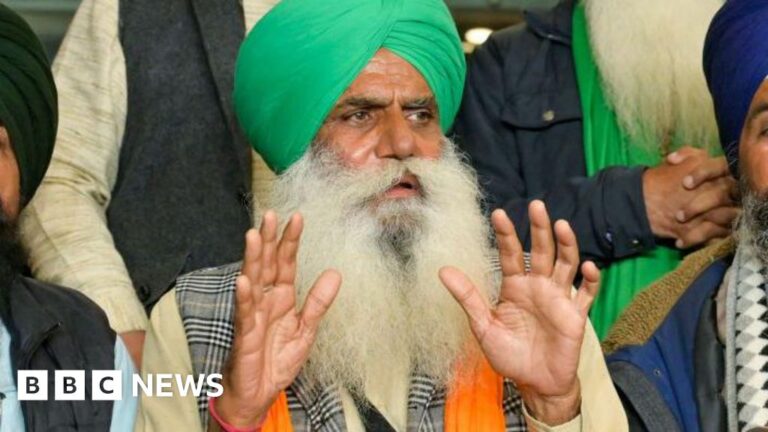Getty Images
Jagjit Singh Dallewal has been on an indefinite hunger strike since November
In India, a 70-year-old farmer leader has been on hunger strike for more than 40 days in a bid to push the federal government to accept the demands of protesting farmers.
Doctors say Jagjit Singh Dallewal’s health has deteriorated and he is “unable to speak”, but he and his supporters have so far refused medical help.
Last month, India’s Supreme Court ordered the state government of Punjab – where Dallewal is from – to transfer him to hospital. The court heard a series of motions related to this issue.
Dallewal’s hunger strike is part of a protest that began in February last year when thousands of farmers gathered at the Punjab-Haryana state border. Their demands include guaranteed prices on certain crops, loan waivers and compensation for the families of farmers who died in previous protests.
Since then, they have tried a few times to march towards the capital Delhi, but were stopped at the border by security forces.
This is not the first time that Indian farmers have staged a massive protest to highlight their issues.
In 2020, they protested for months on Delhi’s borders to demand the repeal of three farm laws introduced by Prime Minister Narendra Modi’s government.
The government claimed the laws would reform the sale of agricultural produce and benefit the community, but farmers argued they would be open to exploitation.
The laws were eventually repealed, but protesting farmers said the government had failed to respond to the rest of their demands made in 2020.
Who is Jagjit Singh Dallewal?
Dallewal is from Punjab, a country that relies heavily on agriculture for employment but is experiencing a steady decline in agricultural income, leading to debt, suicides and migration.
He is the leader of a farmers’ group loosely allied with Samyukta Kisan Morcha, a coalition of dozens of unions that coordinated protests in 2020.
He had earlier led protests against land acquisition in Punjab and demanded compensation for farmers who died by suicide. In 2018, he led a tractor convoy to Delhi to demand implementation of the recommendations of a 2004 government panel that had suggested remunerative prices for farm produce and exemption from farm debt.
In November, before Dallewal began his hunger strike, he was taken to the hospital by state police for a medical examination. But he returned to the protest site a few days later, saying he had been detained in hospital.
In a letter to Modi, he wrote that he was ready to “sacrifice his life” to end the deaths of farmers.
Getty Images
Farmers have been protesting since February last year
What is different about the current protest?
In terms of demands, little has changed compared to previous demonstrations. Farmers are pushing for their unmet demands to be met, including legal guarantee of minimum support prices, debt waiver, pensions for farmers and farm workers, no increase in electricity tariffs, the reinstatement of a law on land acquisition and compensation for the families of farmers who died during previous protests.
But analysts say there appears to be a shift in how Modi’s government is responding to this wave of protests.
During the 2020 protests, the federal government held several negotiations with farmers. Senior officials, including the then Indian Ministers of Agriculture and Food, participated in the negotiations.
Last February, when the farmers announced plans to march to Delhi, top federal ministers held two rounds of talks with their leaders, but failed to secure a breakthrough.
But since then, the federal government appears to have distanced itself from the protests. Last week, when reporters asked Agriculture Minister Shivraj Singh Chouhan if he would invite the protesting farmers for talks, he said the government would follow all directions given by the top court.
Experts believe the government is exercising caution this time to avoid a repeat of what happened in 2020. In October of the same year, a key meeting between the then Agriculture Secretary and farmer unions backfired and catalyzed the year-long protest that followed. .
Getty Images
In 2020, farmers camped outside Delhi for months, forcing the federal government to accept their demands.
What’s next?
In September, the Supreme Court ordered the creation of a committee to look into the farmers’ demands.
The committee submitted an interim report in November, which documented the acute crisis facing Indian farmers. Among other things, the report highlights the extremely low wages that farmers earn and the massive debts under which they are drowning.
It also says more than 400,000 farmers and farm workers have committed suicide since 1995, when India’s National Crime Records Bureau began collecting data.
The committee also proposed solutions, including offering farmers direct income support.
The group is reportedly examining solutions to increase agricultural income. Negotiations with various farmers’ unions were planned for January.
But some groups refused to meet with them, saying negotiations weren’t helping them and that the committee should work to provide a safe space to hold protests.
Follow BBC News India on Instagram, YouTube, Twitter and Facebook

